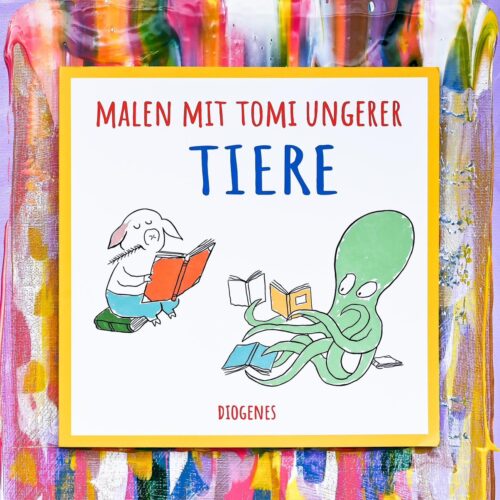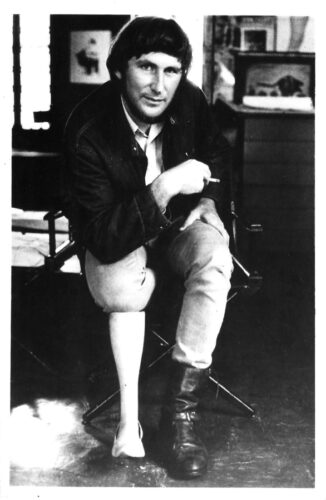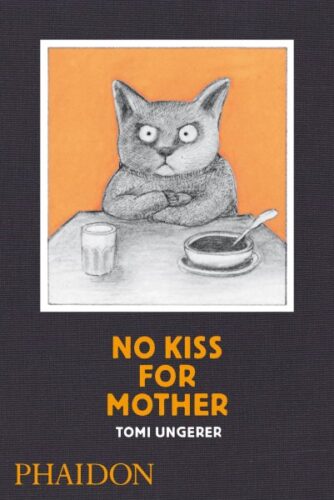Stay Curious, Ask Lots of Questions, Don’t Trust Adults: Tomi Ungerer and His Legacy / Coloring Book
True story. When I was pregnant with my first child, I still had a fair amount of energy left in me, so I’d attend any event I could before the delivery day. And while it was cutting it a bit close, I was excited because Tomi Ungerer was coming to New York City and I was finally going to get a chance to meet him live and in person! Tomi Ungerer, for those of you unfamiliar with his work, was one of children’s literature’s more eclectic and interesting talents. You may have seen his Crictor, and you’ve undoubtedly seen his Three Robbers, but he had so many more stories out there. Lisa Brown probably wrote the best tribute to the man possible for the journal VQR in a piece called Beastly Boy: Tomi Ungerer and the Art of Provocation. In it, she calls the man “Saul Steinberg for the kiddie set” and she ain’t wrong.
If Ungerer’s life was one of complications, his afterlife may be just as interesting. Tomi died in February of 2019 and I never did have a chance to meet him. The day I was to attend his party I went into labor and found myself engaging in an activity that I think he would have found an amusing counterpoint to that celebration of his work.
ADVERTISEMENT
ADVERTISEMENT
Now I’m slated to go to Bologna for the international children’s book fair. While there, an acquaintance of mine of many years, Neal Hoskins, will be there as well. Neal is now marketing content for the Tomi Ungerer and recently he sent me a funny little book called Painting With Tomi Ungerer: Animals. It’s a little coloring book of Tomi’s work, so I had questions. Today, Neal, Aria Ungerer (Tomi’s daughter and the creative lead of her father’s estate) and Rahel Bunter (Designer for this project from Diogenes) are on hand to answer them. This is a transcription of the three of them, answering my questions.
Betsy Bird: Thanks so much for joining me, all of you! So just to kick things off from the start, I’d like you to give us all a little background information. What precisely is TIERE? Where did it come from? And what should Tomi Ungerer fans expect?

Neal Hoskins: Well, some time in 2019, an Icelandic publisher made some coloring walls of Tomi’s illustrations for a book event. I think we got in touch as the estate and said, Hey these look great! Can we promote one of these too? And then we made a 2019 Christmas card to color in with Tomi’s main publisher in Switzerland, Diogenes. Then we had the pandemic, and during that time we kind of noticed how popular the free downloads were. So, during the tail end of 2021, we met for the first in a while in Zurich, got out a pile of books around the table, and said, Dare we make a whole book? A Tomi Ungerer coloring book? And we thought, let’s try and see where we go! But it’s got to be a Tomi painting book, and so was born Painting With Tomi Ungerer: Animals.
Aria Ungerer: What should Tomi fans expect? I mean, maybe to be participants to his drawings and to his illustrations and to get more into his world, rather than just be a reader. Become, like, little artists being their own master. Sort of, which color to put and how to put them, and then which direction the stroke of the pen is going.
Rahel Bunter: I think that’s quite an interesting approach to get to know an artist. Have an idea, but then at some point you can be part of it. Is it worth mentioning, Aria, that Tomi was always keen when people used to sort of layer on things to his work?
So it’s almost as if a coloring book wouldn’t be that far away from what he’d like. Part of his work that people could add to it or add their own interpretations. He always wanted to inspire people to draw and write and do stuff.
BB: Sure, but a coloring book is tricky for some of us. Librarians as a rule tend to avoid what we consider “consumables” when it comes to circulating titles. I think this book may have applications far beyond that, though. How do you envision this title being used with children?
RB: Yeah. I think an interesting part of this coloring book that often in coloring books, it’s new drawings. But these drawings already existed and we took them out of real stories that already existed and put them in surprisingly new compilations. We made new stories by putting them together.
From that new compilation you have a whole new story, which depends on how they draw in and what they add. Because there’s a lot of whites. So maybe they draw in new flowers or a wardrobe. I think that what’s makes a coloring book also very special. That it’s not just animals.

What you would expect from an animal coloring book you would expect. Okay, it’s just compilation of different animals and that’s it. But it’s not only animals, it tells you stories.
AU: Leading on from what Rahel is saying, it’s like there are little mini narratives on each page. You can enter those narratives in a lot of different ways. You can enter them on a purely surface level, you know, just coloring in, enjoying adding your own elements, but you can also enter into those narratives in a very different way as well.
The viewer or the child who’s engaging with what they see, they can go in and like create their own story. For the relationship between an adult and a child doing an activity together, drawing can be just sort of a passive kind of mindless thing. But because there are these little mini narratives on each page, it’s a way that a child and an adult can work together to create a new story out of these little minis. Because as Rahel said, it’s not just objects randomly on a page that are just there for the visual effect or the visual pleasure. There’s also something there that can really stimulate the storyteller in the child, and I think that’s really, really educational and important.
And I think also we worked to make sure that it’s interesting for adults as well. As an adult you’re not going, oh, here we go again. As an adult you could really enjoy this as well. There are little, almost subversive bits, images in the book, which I think could be really fun for everybody.
That can be like a lifelong passion for books. And in this case, specifically children’s picture books. I think that libraries usually have a lot of activities that they put together in order to bring children and readers of different ages together. When you have one book or one image and you have many children and many adults and many different people together, so many things can happen that you just don’t expect.
And so I think that, this being a coloring book, it’s a really fantastic. It’s just giving you the potential. It’s giving that little kernel that with kids, their imagination can go wild. There’s loads in there to stimulate, to make the child an active participant like Rahel said.
And there’s loads of things there that are starting points for different kinds of discussions about relativity, about compassion, about absurdity. From these coloring pages into Tomi’s book or even any book. To not hammer a marketing line down.
You know, this is a visual literacy exercise as well, because then you can actually pick up a story book and find some of the characters in the stories. Maybe you’d like to read some of stories or even start reading some other picture book stories to do with animals. So, you know there’s a lot in there to inspire young readers.

Or young beginning readers, let’s say, even if they’re coloring. When you’re very young, things are being read to you, but you learn them by heart. And you know, young kids often know exactly the lines of the texts, so even though they’re not reading in one way, but in another way they are kind of reading. We’re actually aiming to proactively encourage and stimulate a child’s curiosity and a child’s engagement with story making or storytelling. I think it can be used as an educational tool that links to other books.
BB So, to your mind, what do you feel is the lasting legacy of Tomi Ungerer? Why do we still talk about him today?
AU: His books are modern classics because I think he never spoke down to children.
He always treated his child readers as equals. Not just with respect but as equals. Partly because he himself never quite grew up. In a way it makes me think sometimes there is so, Despite cultural history, there is something timeless about the state of childhood and it’s interesting. I think the way that he is able to tap into that state and speak to that state directly on some level makes the work timeless. And you know, some things about it might age, perhaps over time, you know, stylistically. But I think in terms of the ideas, in terms of the narratives… Tomi always said he worked in a way where the style had to serve the idea.
So the idea is the most important thing when you create. His style changed many, many times over because the style has to serve the idea. We can always return to that. In terms of the legacy, fundamentally I think one of the most important thing that Tomi is reminding children/encouraging children not to be defined by the expectations or the opinions of other people. Stay curious, ask lots of questions, don’t trust the adults and whatever is happening around you in the adult world or in school, your thoughts are free.
I think his work really encourages that freedom of thought in a young person. So I think that’s my not too short answer. Do you have anything to add to that, Rahel?
RB: Yeah. It’s an interesting thing though, isn’t? Why do some do music? Why do some do art? Why do they have that resonance today? You know, why do people still read the books of Dickens?
Even though they’re slightly antiquated, in the linguistic form of the word, they still have this power to attract people. Why do you think that is for Tomi’s books? I don’t think any of them really date or really suffered. Maybe some of the ones he did with other people, but his own, I don’t see any of it slipping out and being reviewed or being even reconsidered. I know you say that his work’s considered a classic, but some classics have fallen off or become reconsidered and rethought that perhaps that wasn’t such a great classic. There’s another piece that happens as well, and that only happens over a longer period of time.
Tomi was at the forefront of an enormous shift and change in what was considered suitable as a children’s book. Therefore, he was a kind of pioneer at the time, I think that means that he influenced a lot of people. There’s also that thing where you can trace the influence back.
People who are making brand new books today have been referring back to Tomi’s work, or they have been influenced by it. There’s this continuity. It does keep that link, even if subconsciously. That link remains.
That’s part of what makes something a classic too, that it feels timeless.
BB: Any chance that we’ll see other titles like TIERE in the future or would this be a one off?
NH: We hope so – hence the sort of subtitle of painting with Tomi Ungerer: Animals. Publishers are great at series and Diogenes is a great and thoughtful publisher. Look at the weight of the paper and how easily it would open for drawing. Attention to detail here.
BB: Hard hitting final question: What’s your favorite Tomi Ungerer book?

RB: I can’t choose one. They’re just too many and they’re all excellent. I think there are different books at different times, so I have to put No Kiss for Mother on my list because, I mean, I just love that book so much. And there are some drawings in there. I don’t know if somebody would publish them nowadays.
AU: I would have to choose Nonstop because it was the very last book that Tomi made. I worked with him extensively on that book for several years, you know, in two completely different versions of it. And I edited the book with him. I think it’s an important book for our time. You know, in an bleak kind of way it addresses war and it addresses environmental disaster. All the worst things that can happen, but yet the book is full of hope and it’s about the importance of love and friendship in difficult, challenging times.
NH: I love Fog Island – I always come back to it for the story and the setting and, most of all, how it’s careful in what it doesn’t say, or places it doesn’t go.
Big thanks to Neal, Aria, and Rahel for taking the time to answer my questions today. And if any of you happen to be at the Bologna Book Festival this year, you may be interested in the following:
MASTERCLASS – 06/03/2022 14:00-14:50
Title: Long Live Tomi Ungerer
Description: Martin Salisbury, joined by artists Beatrice Alemagna and Axel Scheffler for a discussion about Tomi Ungerer’s influence on their work and the world of contemporary children’s books. This event will be followed by the official opening of the #remembering Tomi artist’s wall.
Panel: Chair Martin Salisbury, Cambridge School Of Art and Anglia Ruskin University; Axel Scheffler, Illustrator; Beatrice Allemagna, Illustrator
Filed under: Interviews
About Betsy Bird
Betsy Bird is currently the Collection Development Manager of the Evanston Public Library system and a former Materials Specialist for New York Public Library. She has served on Newbery, written for Horn Book, and has done other lovely little things that she'd love to tell you about but that she's sure you'd find more interesting to hear of in person. Her opinions are her own and do not reflect those of EPL, SLJ, or any of the other acronyms you might be able to name. Follow her on Twitter: @fuseeight.
ADVERTISEMENT
ADVERTISEMENT
SLJ Blog Network
Happy Poem in Your Pocket Day!
Family Style: Memories of an American from Vietnam | Review
Parsing Religion in Public Schools
Environmental Mystery for Middle Grade Readers, a guest post by Rae Chalmers
ADVERTISEMENT







